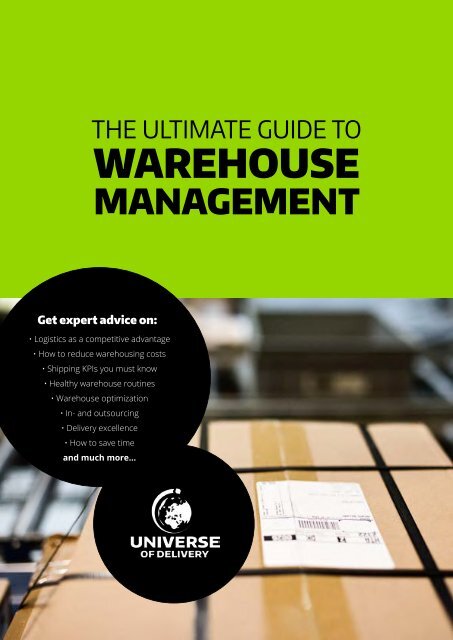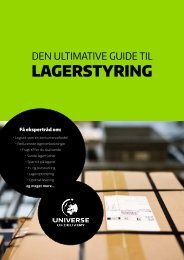The Ultimate guide to Warehouse management
You also want an ePaper? Increase the reach of your titles
YUMPU automatically turns print PDFs into web optimized ePapers that Google loves.
THE ULTIMATE GUIDE TO<br />
WAREHOUSE<br />
MANAGEMENT<br />
Get expert advice on:<br />
• Logistics as a competitive advantage<br />
• How <strong>to</strong> reduce warehousing costs<br />
• Shipping KPIs you must know<br />
• Healthy warehouse routines<br />
• <strong>Warehouse</strong> optimization<br />
• In- and outsourcing<br />
• Delivery excellence<br />
• How <strong>to</strong> save time<br />
and much more...
7 TIPS:<br />
How <strong>to</strong> optimize your warehouse<br />
Use these tips <strong>to</strong> optimize your warehouse and save hours as well as offer your<br />
cus<strong>to</strong>mers a faster and more accurate delivery. You can use the 7 tips again and<br />
again <strong>to</strong> ensure that your warehouse is always optimized for your cus<strong>to</strong>mers’,<br />
employees’ and the future’s requirements.<br />
1.<br />
2.<br />
3.<br />
4.<br />
5.<br />
6.<br />
7.<br />
Use the space in the warehouse wisely<br />
Take advantage of the height of the warehouse by installing a<br />
mezzanine or take advantage of floor areas by using mobile<br />
shelving in order <strong>to</strong> fit more items on the same surface.<br />
Clean up your product range<br />
Do not let items that you cannot sell, occupy the space in the warehouse<br />
for other more popular items. Goods must always be shortest<br />
possible time at the warehouse, so you do not lose money.<br />
Know your goods<br />
Place the goods in the warehouse in relation <strong>to</strong> whether they<br />
are high or low frequency goods.<br />
Pick orders faster<br />
Pick several orders at once (batch picking) and organize the warehouse,<br />
so the employee does not have <strong>to</strong> walk long distances.<br />
Check your goods<br />
Keep track of loss, expiration date, manufacturing defects and<br />
returns through routines and cus<strong>to</strong>m software solutions.<br />
Prioritize good ergonomic working postures<br />
High tables, assembly lines and changing working postures help<br />
<strong>to</strong> reduce sickness absence among warehouse employees and<br />
increase productivity.<br />
Make your warehouse processes scalable<br />
With a scalable logistics solution, you can easily up- and downgrade<br />
in relation <strong>to</strong> high and low season. You do not need <strong>to</strong> invest in<br />
expensive and oversized logistics solutions, if you do not need it.<br />
Sindre Landevåg, CEO<br />
Get Inspired<br />
”<br />
A larger warehouse, new WMS and Delivery<br />
Management software and more racks, plastic<br />
boxes and picking carts create better working<br />
conditions for our warehouse employees, and<br />
makes our logistics scalable and foreseeable<br />
as well as enables us <strong>to</strong> offer our cus<strong>to</strong>mers a<br />
faster and more accurate delivery.<br />
Do you want <strong>to</strong> learn more about Get Inspired’s<br />
successful warehouse <strong>management</strong>?<br />
Click here!<br />
80% of the world’s warehouses<br />
are managed without any<br />
au<strong>to</strong>mated systems or robot<br />
technology at all.<br />
Source: Universe of Delivery
INSOURCING VS.<br />
OUTSOURCING<br />
Get the experts’ advice here...<br />
Strategy<br />
When you outsource your warehouse, you also outsource logistics<br />
competencies instead of building them yourself. If you have good<br />
logistics at the warehouse, favorable carrier agreements and a desire<br />
<strong>to</strong> actively use logistics as your competitive advantage, you write<br />
off this possibility <strong>to</strong> affect how you work with logistics as a competitive<br />
fac<strong>to</strong>r, if you outsource your warehouse <strong>to</strong> a 3PL player.<br />
Benefits:<br />
Build logistics competencies in-house and directly affect how you<br />
make logistics work as a competitive advantage for your business.<br />
When should you insource your warehouse?<br />
What fac<strong>to</strong>rs should you consider if you want <strong>to</strong> run your warehouse yourself<br />
rather than outsourcing? And what are the benefits of insourcing your warehouse?<br />
Steffen Larvoll gives you the answer here.<br />
First of all, it is vital that you pre-calculate the costs and include your business strategy<br />
and future, before you decide whether <strong>to</strong> in- or outsource your warehouse.<br />
This decision-process can be split in<strong>to</strong> three areas.<br />
Practicalities<br />
An insourced warehouse is practical if you want the possibility <strong>to</strong>:<br />
• Check inven<strong>to</strong>ry<br />
• Process orders<br />
• Adjust orders<br />
• Change deliveries<br />
• Offer pick-up of online orders<br />
Benefits:<br />
You are able <strong>to</strong> offer a more flexible delivery as well as several<br />
delivery options. This increases cus<strong>to</strong>mer satisfaction. Insourcing is<br />
also beneficial, if your product range is constantly changing, as you<br />
do not have <strong>to</strong> coordinate the changes with an external 3PL player.<br />
Economy<br />
Calculate the costs of running your own warehouse, and compare<br />
these with the price of a 3PL player.<br />
Start-up costs: premises, equipment, trucks,<br />
packaging, WMS and EDI systems and staffing<br />
Daily operation costs: wages, power consumption,<br />
repairs and software licenses<br />
Buffer costs: new inven<strong>to</strong>ry, seasonal variations<br />
and unpredictable costs<br />
Benefits:<br />
<strong>The</strong> costs of insourcing may seem heavy at startup, but in return<br />
you have full control, and you are able <strong>to</strong> reduce costs through<br />
warehouse optimization. 3PL players have a fixed price, which you<br />
cannot control. If you just can do it marginally cheaper than a 3PL<br />
player, this is of great importance in the long term.<br />
Steffen Larvoll, Market Manager<br />
Lager- og Industrisystemer<br />
”<br />
<strong>The</strong> e-commerce industry is an industry where<br />
insourcing can be beneficial. E-commerce is volatile<br />
with rapidly changing trends and rigorous<br />
demands from online consumers on flexible<br />
delivery.<br />
E-tailers must be dynamic and adaptable, and<br />
here insourcing of the warehouse can be particularly<br />
beneficial.
In average companies use<br />
2.8 different carriers<br />
for their shipments<br />
Source: Consignor<br />
RFID technology<br />
is increasingly used <strong>to</strong><br />
identify and track shipments<br />
Source: Consignor<br />
When should you outsource your warehouse?<br />
What are the benefits of outsourcing your warehouse? And when should<br />
you consider outsourcing rather than run your warehouse yourself? Fredrik<br />
Krysén from Aditro Logistics gives you the answer here.<br />
<strong>The</strong> biggest advantage of an outsourced warehouse is that it allows for companies<br />
<strong>to</strong> focus on their core business in a greater degree, because they do not have <strong>to</strong><br />
spend time managing warehouse and transport.<br />
<strong>The</strong> main financial benefits of outsourcing are:<br />
• Lower costs thanks <strong>to</strong> economies of scale in warehouse and transport<br />
• More efficient logistics processes<br />
• Reduced capital tie<br />
• Reducing the administrative burden<br />
Outsourcing is a good idea, if you...<br />
...consider new markets or products.<br />
New markets, products or just seasonal fluctuations are easier <strong>to</strong><br />
manage through a third party who handles the s<strong>to</strong>rage and transport<br />
of your goods.<br />
Benefit: Reduce the otherwise higher costs associated with new<br />
carrier agreements and varying inven<strong>to</strong>ries. This way your logistics<br />
becomes scalable and flexible.<br />
”<br />
...want more efficient transport.<br />
A 3PL opera<strong>to</strong>r consolidates multiple companies’ shipments. Benefit:<br />
This makes shipping of your orders cheaper and more effective<br />
than sporadic shipments.<br />
...want logistical experience and expertise.<br />
Many companies don’t have logistics as their core business.<br />
Benefit: By utilizing 3PL players’ industry knowledge and logistical<br />
expertise, the company will stand stronger.<br />
Fredrik Krysén, Transport Direc<strong>to</strong>r<br />
Aditro<br />
For many companies, logistics are not part of their core<br />
business, and not prioritized by the <strong>management</strong>. If<br />
they choose <strong>to</strong> insource their warehouse this can be<br />
both costly and time-consuming.<br />
Outsourcing logistics allows for savings for up <strong>to</strong><br />
10-20%, and release time and opportunity for<br />
a company <strong>to</strong> focus on its core competencies.
6<br />
KPIs<br />
every warehouse<br />
manager should know<br />
What are the key fac<strong>to</strong>rs <strong>to</strong> optimize and measure on when sending parcels<br />
from your warehouse? We have asked experts in the field and gathered a<br />
number of KPIs that every logistics and warehouse manager should know.<br />
<strong>The</strong> process behind a shipment can be split in<strong>to</strong> several parts, each of which can<br />
be measured and optimized. KPIs (Key Performance Indica<strong>to</strong>rs) are objectives<br />
which an employee or a department can work <strong>to</strong>wards in order <strong>to</strong> optimize a<br />
company’s processes.<br />
We have asked experts about which KPIs are most valuable <strong>to</strong> measure when you<br />
want <strong>to</strong> optimize shipment and delivery processes in your business. Here are their<br />
answers.<br />
2.<br />
Label print<br />
You can increase the speed in several ways, when your parcel has <strong>to</strong> be labelled<br />
with the correct transport label. Firstly, integration and reuse of data<br />
from backend systems is important, as you save time compared <strong>to</strong> manual<br />
typing of information. You’ll also save time by au<strong>to</strong>mating the choice of<br />
shipping method through a system of rules.<br />
Once everything is correctly set up, it must not take more than 1 second<br />
from the order number being scanned and retrieved from another system<br />
<strong>to</strong> the label being produced. This is not the case for all warehouses, which<br />
is why many would achieve significant optimization by au<strong>to</strong>mating this.<br />
– Vice President, Steffen Pasgaard, Consignor.<br />
1. Picking<br />
<strong>The</strong> process of picking of goods can be divided. You can affect the overall<br />
speed by optimizing every single part. <strong>The</strong>refore, picking speed depends<br />
on several fac<strong>to</strong>rs: how the order list is designed in relation <strong>to</strong> the location<br />
of the products in the warehouse, time devoted <strong>to</strong> picking of goods, the<br />
size of the products <strong>to</strong> be picked, and whether picking is done by robots or<br />
humans.<br />
A KPI for picking speed can therefore vary a lot. A concrete example of a<br />
KPI for a warehouse with 250,000 different small items may be picking 30-<br />
60 order lines per man per hour.<br />
– Transport Direc<strong>to</strong>r, Fredrik Krysén, Aditro Logistics.<br />
3. Packing<br />
It is faster <strong>to</strong> pack a shipment when the package has the correct size for the<br />
specific product. <strong>The</strong>refore, it is often worth the effort <strong>to</strong> choose a slightly<br />
more expensive cardboard box if it means faster packing and thus time<br />
and resource savings.<br />
In general, it is important <strong>to</strong> optimize your packaging as<br />
best as possible. If you use stretch film for your shipments,<br />
you can often choose a lower thickness of stretch film,<br />
which adds several meters <strong>to</strong> the roll. This means fewer<br />
roll changes on the machine and faster packaging<br />
speed, so you can use your time on other tasks.<br />
– Sales Direc<strong>to</strong>r, Michael Simonsen, STOK Emballage.<br />
7 out of 10<br />
companies use <strong>to</strong>o<br />
much packaging<br />
Source: Universe Of Delivery
4. Tracking<br />
80-90% of the cus<strong>to</strong>mer experience depends on<br />
the delivery, and transparency and on-time delivery<br />
is essential. <strong>The</strong>refore, it is important that you are<br />
able <strong>to</strong> quickly and easily track shipments when<br />
cus<strong>to</strong>mers call wanting <strong>to</strong> know the shipping status<br />
of their parcels.<br />
73% of online consumers think that<br />
track & trace and knowledge about the<br />
delivery time will make them shop<br />
even more online<br />
Source: Universe of Delivery<br />
We have reduced the cus<strong>to</strong>mer processing time from 70<br />
seconds <strong>to</strong> 15 seconds when cus<strong>to</strong>mer service track parcels<br />
for cus<strong>to</strong>mers, as we now do it in an online portal, which is regularly updated<br />
with status on the shipments we produce. <strong>The</strong>reby, we are able <strong>to</strong><br />
immediately track parcels by logging on <strong>to</strong> the portal online without disturbing<br />
the different carriers, as all shipment numbers are captured in one<br />
complete system. Cus<strong>to</strong>mers can also track parcels by themselves in the<br />
portal.<br />
– CEO, Jesper Hvejsel, Firtal.<br />
5.<br />
Delivery time<br />
Geography and service affect the time of delivery of<br />
your shipments. Day-<strong>to</strong>-day delivery is widespread in<br />
small geographies; great distances take 2-7 days while<br />
one-hour delivery is gradually becoming an offer in urban<br />
areas where the location of the warehouse allows this.<br />
Delivery time is a parameter that is increasingly focused on<br />
– and several carriers position themselves with new services particularly related<br />
<strong>to</strong>; delivery time delivery in the evening, on the weekend or next day<br />
<strong>to</strong> e.g. the Middle East can mean the difference between getting the order<br />
or not.<br />
When using delivery as a competitive <strong>to</strong>ol, it is important <strong>to</strong><br />
measure the effect of your choice: On-time delivery is an<br />
important KPI for all senders – especially when you have<br />
made a commitment <strong>to</strong> the receiver <strong>to</strong> deliver within a<br />
certain time frame. KPI for on-time delivery must<br />
therefore naturally be as close <strong>to</strong> 100% as possible.<br />
– Vice President, Steffen Pasgaard, Consignor.<br />
Consumers are willing <strong>to</strong><br />
pay up <strong>to</strong> 6 times more for a<br />
convenient delivery option.<br />
Source: Bringg<br />
6.<br />
54% of online shoppers think<br />
about returning an item before<br />
they have even purchased it!<br />
Source: eDelivery<br />
Return time<br />
Attractive return options as well as simple and<br />
efficient returns <strong>management</strong> at the warehouse<br />
is important. When we receive returns at the warehouse,<br />
we register the product with a few clicks and use the invoice<br />
number <strong>to</strong> identify the order in a return portal. Both cus<strong>to</strong>mers and cus<strong>to</strong>mer<br />
service are able <strong>to</strong> track returns in the portal. When cus<strong>to</strong>mers print<br />
return labels from our site, they fill out a form as <strong>to</strong> why they want <strong>to</strong> return<br />
the item e.g. wrong size, credit or repair.<br />
That way we can more quickly handle the return, and the cus<strong>to</strong>mer gets a<br />
faster processing. It maximum takes two days from when we have received<br />
the return at the warehouse <strong>to</strong> the cus<strong>to</strong>mer receiving a refund. Generally,<br />
it is important <strong>to</strong> keep the number of returns at a minimum by using good<br />
product descriptions, product videos, size <strong>guide</strong>s and FAQs.<br />
– E-commerce Manager, Jonas Larsen, Friluftsmagasinet.






